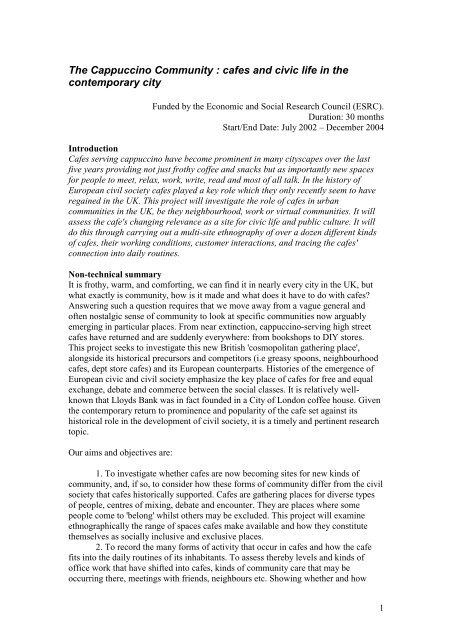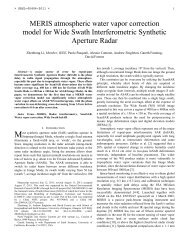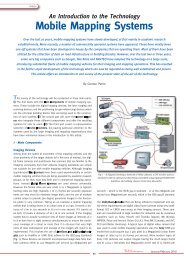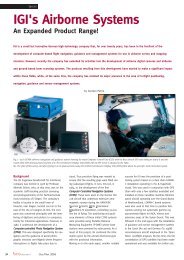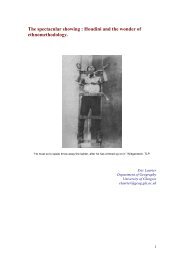The Cappuccino Community : cafes and civic life in the ...
The Cappuccino Community : cafes and civic life in the ...
The Cappuccino Community : cafes and civic life in the ...
Create successful ePaper yourself
Turn your PDF publications into a flip-book with our unique Google optimized e-Paper software.
<strong>The</strong> <strong>Cappucc<strong>in</strong>o</strong> <strong>Community</strong> : <strong>cafes</strong> <strong>and</strong> <strong>civic</strong> <strong>life</strong> <strong>in</strong> <strong>the</strong><br />
contemporary city<br />
Funded by <strong>the</strong> Economic <strong>and</strong> Social Research Council (ESRC).<br />
Duration: 30 months<br />
Start/End Date: July 2002 – December 2004<br />
Introduction<br />
Cafes serv<strong>in</strong>g cappucc<strong>in</strong>o have become prom<strong>in</strong>ent <strong>in</strong> many cityscapes over <strong>the</strong> last<br />
five years provid<strong>in</strong>g not just frothy coffee <strong>and</strong> snacks but as importantly new spaces<br />
for people to meet, relax, work, write, read <strong>and</strong> most of all talk. In <strong>the</strong> history of<br />
European civil society <strong>cafes</strong> played a key role which <strong>the</strong>y only recently seem to have<br />
rega<strong>in</strong>ed <strong>in</strong> <strong>the</strong> UK. This project will <strong>in</strong>vestigate <strong>the</strong> role of <strong>cafes</strong> <strong>in</strong> urban<br />
communities <strong>in</strong> <strong>the</strong> UK, be <strong>the</strong>y neighbourhood, work or virtual communities. It will<br />
assess <strong>the</strong> cafe's chang<strong>in</strong>g relevance as a site for <strong>civic</strong> <strong>life</strong> <strong>and</strong> public culture. It will<br />
do this through carry<strong>in</strong>g out a multi-site ethnography of over a dozen different k<strong>in</strong>ds<br />
of <strong>cafes</strong>, <strong>the</strong>ir work<strong>in</strong>g conditions, customer <strong>in</strong>teractions, <strong>and</strong> trac<strong>in</strong>g <strong>the</strong> <strong>cafes</strong>'<br />
connection <strong>in</strong>to daily rout<strong>in</strong>es.<br />
Non-technical summary<br />
It is frothy, warm, <strong>and</strong> comfort<strong>in</strong>g, we can f<strong>in</strong>d it <strong>in</strong> nearly every city <strong>in</strong> <strong>the</strong> UK, but<br />
what exactly is community, how is it made <strong>and</strong> what does it have to do with <strong>cafes</strong>?<br />
Answer<strong>in</strong>g such a question requires that we move away from a vague general <strong>and</strong><br />
often nostalgic sense of community to look at specific communities now arguably<br />
emerg<strong>in</strong>g <strong>in</strong> particular places. From near ext<strong>in</strong>ction, cappucc<strong>in</strong>o-serv<strong>in</strong>g high street<br />
<strong>cafes</strong> have returned <strong>and</strong> are suddenly everywhere: from bookshops to DIY stores.<br />
This project seeks to <strong>in</strong>vestigate this new British 'cosmopolitan ga<strong>the</strong>r<strong>in</strong>g place',<br />
alongside its historical precursors <strong>and</strong> competitors (i.e greasy spoons, neighbourhood<br />
<strong>cafes</strong>, dept store <strong>cafes</strong>) <strong>and</strong> its European counterparts. Histories of <strong>the</strong> emergence of<br />
European <strong>civic</strong> <strong>and</strong> civil society emphasize <strong>the</strong> key place of <strong>cafes</strong> for free <strong>and</strong> equal<br />
exchange, debate <strong>and</strong> commerce between <strong>the</strong> social classes. It is relatively wellknown<br />
that Lloyds Bank was <strong>in</strong> fact founded <strong>in</strong> a City of London coffee house. Given<br />
<strong>the</strong> contemporary return to prom<strong>in</strong>ence <strong>and</strong> popularity of <strong>the</strong> cafe set aga<strong>in</strong>st its<br />
historical role <strong>in</strong> <strong>the</strong> development of civil society, it is a timely <strong>and</strong> pert<strong>in</strong>ent research<br />
topic.<br />
Our aims <strong>and</strong> objectives are:<br />
1. To <strong>in</strong>vestigate whe<strong>the</strong>r <strong>cafes</strong> are now becom<strong>in</strong>g sites for new k<strong>in</strong>ds of<br />
community, <strong>and</strong>, if so, to consider how <strong>the</strong>se forms of community differ from <strong>the</strong> civil<br />
society that <strong>cafes</strong> historically supported. Cafes are ga<strong>the</strong>r<strong>in</strong>g places for diverse types<br />
of people, centres of mix<strong>in</strong>g, debate <strong>and</strong> encounter. <strong>The</strong>y are places where some<br />
people come to 'belong' whilst o<strong>the</strong>rs may be excluded. This project will exam<strong>in</strong>e<br />
ethnographically <strong>the</strong> range of spaces <strong>cafes</strong> make available <strong>and</strong> how <strong>the</strong>y constitute<br />
<strong>the</strong>mselves as socially <strong>in</strong>clusive <strong>and</strong> exclusive places.<br />
2. To record <strong>the</strong> many forms of activity that occur <strong>in</strong> <strong>cafes</strong> <strong>and</strong> how <strong>the</strong> cafe<br />
fits <strong>in</strong>to <strong>the</strong> daily rout<strong>in</strong>es of its <strong>in</strong>habitants. To assess <strong>the</strong>reby levels <strong>and</strong> k<strong>in</strong>ds of<br />
office work that have shifted <strong>in</strong>to <strong>cafes</strong>, k<strong>in</strong>ds of community care that may be<br />
occurr<strong>in</strong>g <strong>the</strong>re, meet<strong>in</strong>gs with friends, neighbours etc. Show<strong>in</strong>g whe<strong>the</strong>r <strong>and</strong> how<br />
1
<strong>cafes</strong> have becomes nodes <strong>in</strong>terconnect<strong>in</strong>g work, leisure, study, casual encounters <strong>and</strong><br />
society <strong>in</strong> general.<br />
3. To describe <strong>the</strong> practical 'work' that is accomplished by both customers <strong>and</strong><br />
staff <strong>in</strong> creat<strong>in</strong>g <strong>and</strong> ma<strong>in</strong>ta<strong>in</strong><strong>in</strong>g <strong>cafes</strong> as sites of rule-guided <strong>in</strong>teraction. To consider<br />
how certa<strong>in</strong> people come to be regulars <strong>in</strong> different k<strong>in</strong>ds of <strong>cafes</strong>, how customers<br />
sometimes become acqua<strong>in</strong>ted, <strong>the</strong> rights <strong>and</strong> obligations of various k<strong>in</strong>ds that are<br />
found <strong>the</strong>re.<br />
4. To conduct an ethnographic study of 12 <strong>cafes</strong> <strong>in</strong> <strong>the</strong> UK, 3 <strong>in</strong>-depth, <strong>and</strong> 9<br />
shorter studies. <strong>The</strong> <strong>in</strong>-depth studies <strong>in</strong>volv<strong>in</strong>g participant-observation as a staff<br />
member, as a regular <strong>and</strong> also <strong>the</strong> shadow<strong>in</strong>g of 36 customers <strong>in</strong> <strong>the</strong>ir daily rout<strong>in</strong>es<br />
(12 from each cafe).<br />
5. To make use of video <strong>in</strong> ga<strong>the</strong>r<strong>in</strong>g observational data of naturally occurr<strong>in</strong>g<br />
social <strong>in</strong>teraction. With <strong>the</strong> assistance of edit<strong>in</strong>g facilities <strong>and</strong> computer assisted<br />
tagg<strong>in</strong>g <strong>and</strong> <strong>in</strong>dex<strong>in</strong>g packages to analyse (<strong>and</strong> present via multi-media) how people<br />
<strong>in</strong>teract <strong>and</strong> make communities via practical activities <strong>in</strong> real time.<br />
Detailed Aims <strong>and</strong> objectives<br />
1. To <strong>in</strong>vestigate <strong>the</strong> dist<strong>in</strong>ctive forms of community found <strong>in</strong> <strong>cafes</strong> <strong>and</strong> what grounds<br />
<strong>the</strong>y provide for a vital <strong>civic</strong> <strong>life</strong> <strong>in</strong> <strong>the</strong> city. This aim builds on <strong>the</strong> historical evidence<br />
of <strong>the</strong> importance of <strong>cafes</strong> to <strong>the</strong> rise of civil society <strong>in</strong> Europe <strong>and</strong> seeks to situate<br />
<strong>the</strong>m <strong>in</strong> a contemporary context. Studies of community <strong>life</strong> <strong>in</strong> <strong>the</strong> USA <strong>and</strong> <strong>the</strong> UK<br />
have often highlighted evidence of its general decl<strong>in</strong>e but <strong>in</strong> many ways have<br />
overlooked <strong>the</strong> new places with<strong>in</strong> which forms of communal <strong>life</strong> are located. This<br />
project will extend <strong>the</strong> communities of practice approach to provide a more grounded<br />
<strong>and</strong> heterogenous underst<strong>and</strong><strong>in</strong>g of community-<strong>in</strong>-action.<br />
2. To document <strong>and</strong> <strong>in</strong>dex <strong>the</strong> varied forms of community <strong>in</strong>teraction <strong>and</strong> social<br />
categoris<strong>in</strong>g that are found <strong>in</strong> <strong>cafes</strong> predom<strong>in</strong>antly <strong>in</strong> <strong>the</strong> UK. What is unquestionable<br />
is that <strong>cafes</strong> support a diversity of activities for <strong>the</strong>ir customers, <strong>the</strong>y also articulate<br />
with <strong>the</strong> daily rout<strong>in</strong>es of <strong>the</strong> customers <strong>in</strong> different ways. <strong>The</strong> project will assemble<br />
an occasioned corpus of customer activities to provide a sense of exactly what k<strong>in</strong>ds<br />
of work, play, sociability occur. Whe<strong>the</strong>r <strong>the</strong>re are meet<strong>in</strong>gs between <strong>the</strong><br />
unacqua<strong>in</strong>ted, who <strong>the</strong> regulars are <strong>and</strong> what rights <strong>and</strong> obligations go with <strong>the</strong>ir<br />
categorisation as a 'regular'.<br />
3. To exam<strong>in</strong>e <strong>the</strong> methods used by staff <strong>and</strong> customers for temporally <strong>and</strong> spatially<br />
organis<strong>in</strong>g <strong>cafes</strong> <strong>in</strong> <strong>the</strong> UK <strong>and</strong> Italy such that public encounters <strong>and</strong> <strong>in</strong>formal<br />
meet<strong>in</strong>gs can occur <strong>the</strong>re. Cafes are places where dist<strong>in</strong>ctive communities of practice<br />
can be found which are reflexively tied to <strong>the</strong>ir sett<strong>in</strong>gs. <strong>The</strong> <strong>civic</strong> freedoms of talk<strong>in</strong>g<br />
to strangers, cross<strong>in</strong>g social hierarchies or publicly debat<strong>in</strong>g news <strong>and</strong> affairs of <strong>the</strong><br />
day come about through <strong>the</strong> sensitive use of codes of conduct rooted <strong>in</strong> <strong>the</strong><br />
background expectations of <strong>cafes</strong> as category-bound sett<strong>in</strong>gs.<br />
4. To do multi-site ethnographies of a dozen <strong>cafes</strong> <strong>in</strong> <strong>the</strong> UK of contrast<strong>in</strong>g types,<br />
draw<strong>in</strong>g on commercial <strong>and</strong> o<strong>the</strong>r categorisations (i.e. franchise, 'greasy spoon',<br />
<strong>in</strong>ternet <strong>and</strong> also neighbourhood, city centre, youth cultured). Of <strong>the</strong>se to select three<br />
for prolonged <strong>in</strong>-depth ethnographies <strong>in</strong>volv<strong>in</strong>g participant-observation of <strong>the</strong> <strong>life</strong> of<br />
2
<strong>the</strong>ir staff, <strong>the</strong> world of customers <strong>and</strong> f<strong>in</strong>ally <strong>the</strong> shadow<strong>in</strong>g of customers to see how<br />
<strong>the</strong> cafe fits <strong>in</strong>to <strong>the</strong>ir daily rout<strong>in</strong>es.<br />
5. To shoot, use <strong>and</strong> analyse video record<strong>in</strong>gs of naturally occurr<strong>in</strong>g <strong>in</strong>teraction <strong>in</strong><br />
<strong>cafes</strong>. Methods of documentary film-mak<strong>in</strong>g regularly used <strong>in</strong> anthropological <strong>and</strong><br />
ethnomethodological studies will be pursued. Once video data has been acquired it<br />
will be <strong>in</strong>dexed <strong>and</strong> analysed accord<strong>in</strong>g to <strong>the</strong> dist<strong>in</strong>ctive <strong>and</strong> rigorous approaches of<br />
conversation-analysis <strong>and</strong> ethnomethodology. In addition research participants will<br />
generate photographic material for analysis <strong>and</strong> discussion.<br />
Methodology<br />
In terms of research practice <strong>the</strong> project will run for two years <strong>and</strong> be based on<br />
ethnographic study spread over approximately a dozen <strong>cafes</strong> <strong>in</strong> <strong>the</strong> UK. Ethnography<br />
is an <strong>in</strong>creas<strong>in</strong>gly popular method for ga<strong>the</strong>r<strong>in</strong>g data <strong>in</strong> <strong>the</strong> social sciences which<br />
relies on <strong>in</strong>habit<strong>in</strong>g <strong>the</strong> sites of <strong>the</strong> populations under study <strong>and</strong> ga<strong>in</strong><strong>in</strong>g an adequate<br />
grasp of how <strong>and</strong> why th<strong>in</strong>gs are done <strong>in</strong> particular places. Study<strong>in</strong>g <strong>cafes</strong> from <strong>the</strong><br />
perspective of a 'native' means jo<strong>in</strong><strong>in</strong>g <strong>in</strong> <strong>the</strong>ir <strong>life</strong>worlds. To do justice to <strong>the</strong><br />
diversity of <strong>cafes</strong>, twelve study sites <strong>in</strong> <strong>the</strong> UK will be selected on <strong>the</strong> criteria of<br />
maximis<strong>in</strong>g contrast. Subsequently three of <strong>the</strong> <strong>in</strong>itial twelve <strong>cafes</strong> will be selected for<br />
<strong>in</strong>-depth exam<strong>in</strong>ation via time-spent becom<strong>in</strong>g 'a regular', observ<strong>in</strong>g its production<br />
alongside <strong>the</strong> staff, <strong>and</strong> f<strong>in</strong>ally shadow<strong>in</strong>g a dozen customers. Preced<strong>in</strong>g <strong>the</strong> eighteen<br />
months of fieldwork, <strong>in</strong>terviews will be carried out with representatives of <strong>the</strong> larger<br />
cafe cha<strong>in</strong>s <strong>and</strong> managers of <strong>the</strong> actual study sites, to provide <strong>the</strong>ir experienced views<br />
on <strong>the</strong> function<strong>in</strong>g <strong>and</strong> <strong>life</strong> of <strong>cafes</strong>. Alongside <strong>in</strong>terviews, once <strong>the</strong> ethnographies are<br />
underway <strong>the</strong> researcher will keep a traditional field journal. Moreover, with<br />
<strong>in</strong>formed-consent videos will be made of social <strong>in</strong>teraction <strong>in</strong> <strong>the</strong> <strong>cafes</strong> for subsequent<br />
analysis <strong>and</strong> shar<strong>in</strong>g amongst <strong>the</strong> research community (<strong>the</strong>y will not be publicly<br />
available). <strong>The</strong> pr<strong>in</strong>cipal <strong>in</strong>vestigator (Eric Laurier) has considerable experience <strong>in</strong><br />
<strong>the</strong> use of video for record<strong>in</strong>g naturalistic observations <strong>in</strong> unusual sett<strong>in</strong>gs (i.e. <strong>in</strong>side<br />
cars, <strong>in</strong>side family homes, public lend<strong>in</strong>g libraries, hotels, shopp<strong>in</strong>g centres <strong>and</strong><br />
<strong>cafes</strong>.) F<strong>in</strong>ally up to thirty six customers will be recruited from <strong>the</strong> three <strong>in</strong>-depth<br />
venues to be shadowed by <strong>the</strong> researcher <strong>and</strong> to use Polaroid cameras to take<br />
illustrative photos of <strong>the</strong>ir daily rout<strong>in</strong>es which will <strong>the</strong>n be used for group<br />
discussions dur<strong>in</strong>g <strong>the</strong> analysis stage of <strong>the</strong> project to <strong>in</strong>vestigate how <strong>the</strong>y are nodes<br />
with<strong>in</strong> <strong>the</strong> network of people's daily lives.<br />
Contact:<br />
Dr Eric Laurier, ESRC Research Fellow, Department of Geography, University of<br />
Glasgow, Glasgow G12 6QQ.<br />
0141 330 4784<br />
07855 361143<br />
elaurier@geog.gla.ac.uk<br />
3


